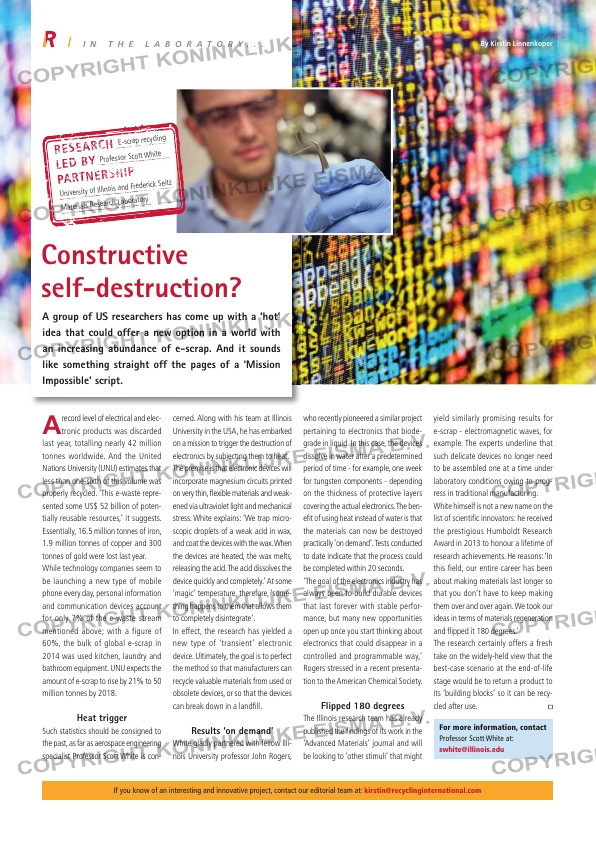Page 47 from: August 2015

I N T H E L A B O R A T O R Y . . .
yield similarly promising results for
e-scrap – electromagnetic waves, for
example. The experts underline that
such delicate devices no longer need
to be assembled one at a time under
laboratory conditions owing to prog-
ress in traditional manufacturing.
White himself is not a new name on the
list of scientifi c innovators: he received
the prestigious Humboldt Research
Award in 2013 to honour a lifetime of
research achievements. He reasons: ‘In
this fi eld, our entire career has been
about making materials last longer so
that you don’t have to keep making
them over and over again. We took our
ideas in terms of materials regeneration
and fl ipped it 180 degrees.’
The research certainly offers a fresh
take on the widely-held view that the
best-case scenario at the end-of-life
stage would be to return a product to
its ‘building blocks’ so it can be recy-
cled after use.
A record level of electrical and elec-tronic products was discarded
last year, totalling nearly 42 million
tonnes worldwide. And the United
Nations University (UNU) estimates that
less than one-sixth of this volume was
properly recycled. ‘This e-waste repre-
sented some US$ 52 billion of poten-
tially reusable resources,’ it suggests.
Essentially, 16.5 million tonnes of iron,
1.9 million tonnes of copper and 300
tonnes of gold were lost last year.
While technology companies seem to
be launching a new type of mobile
phone every day, personal information
and communication devices account
for only 7% of the e-waste stream
mentioned above; with a figure of
60%, the bulk of global e-scrap in
2014 was used kitchen, laundry and
bathroom equipment. UNU expects the
amount of e-scrap to rise by 21% to 50
million tonnes by 2018.
Heat trigger
Such statistics should be consigned to
the past, as far as aerospace engineering
specialist Professor Scott White is con-
who recently pioneered a similar project
pertaining to electronics that biode-
grade in liquid. In this case, the devices
dissolve in water after a predetermined
period of time – for example, one week
for tungsten components – depending
on the thickness of protective layers
covering the actual electronics. The ben-
efi t of using heat instead of water is that
the materials can now be destroyed
practically ‘on demand’. Tests conducted
to date indicate that the process could
be completed within 20 seconds.
‘The goal of the electronics industry has
always been to build durable devices
that last forever with stable perfor-
mance, but many new opportunities
open up once you start thinking about
electronics that could disappear in a
controlled and programmable way,’
Rogers stressed in a recent presenta-
tion to the American Chemical Society.
Flipped 180 degrees
The Illinois research team has already
published the fi ndings of its work in the
‘Advanced Materials’ journal and will
be looking to ‘other stimuli’ that might
cerned. Along with his team at Illinois
University in the USA, he has embarked
on a mission to trigger the destruction of
electronics by subjecting them to heat.
The premise is that electronic devices will
incorporate magnesium circuits printed
on very thin, fl exible materials and weak-
ened via ultraviolet light and mechanical
stress. White explains: ‘We trap micro-
scopic droplets of a weak acid in wax,
and coat the devices with the wax. When
the devices are heated, the wax melts,
releasing the acid. The acid dissolves the
device quickly and completely.’ At some
‘magic’ temperature, therefore, ‘some-
thing happens to them that allows them
to completely disintegrate’.
In effect, the research has yielded a
new type of ‘transient’ electronic
device. Ultimately, the goal is to perfect
the method so that manufacturers can
recycle valuable materials from used or
obsolete devices, or so that the devices
can break down in a landfi ll.
Results ‘on demand’
White gladly partnered with fellow Illi-
nois University professor John Rogers,
Constructive
self-destruction?
A group of US researchers has come up with a ‘hot’
idea that could offer a new option in a world with
an increasing abundance of e-scrap. And it sounds
like something straight off the pages of a ‘Mission
Impossible’ script.
By Kirstin Linnenkoper
If you know of an interesting and innovative project, contact our editorial team at: [email protected]
For more information, contact
Professor Scott White at:
[email protected]
RESEARCH
LED BY
PARTNERSH
IP
E-scrap recycli
ng
Professor Scot
t White
University of Il
linois and Fred
erick Seitz
Materials Rese
arch Laborator
y
RI-6 In the laboratory.indd 3 05-08-15 09:42



